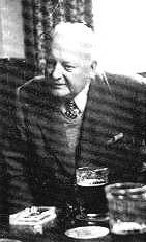How does one look for chief feature? I mean, what is the nature of the “searching-effort” one makes? There are several ways to answer. Something of the effort is described very concisely by Maurice Nicoll, who says that Gurdjieff said to him once: “I not think – I look. Necessary to look” (Selections from Meetings in 1953, 123).
When Gurdjieff said “I not think”, he refers, I believe, to not indulging in formatory thinking. Thought with the higher faculties is something different. I return to this below.
But the first point is that this ties in with Gurdjieff’s advice to Nicoll to take photographs of oneself: “G. once said that it was necessary to collect a large number of photographs of oneself and keep them in an album, so that one could see them together” (Psychological Commentaries, II, 509). This is in one of Nicoll’s papers on chief feature, because the taking and then the comparison of these photographs of myself – inner and outer – is the way to find chief feature.
The only problem with this wisdom is that we can take it as so absolute a rule of conduct that we lose its value. That is, if I imagine that I can or should spend the whole of my existence taking photographs, not thinking but just looking, I would be misguided. If I try and always follow this advice, I will fail. The great danger would be that rather than admit this to myself, something in me will imagine that I am awake.
It is necessary, I suggest, to set aside a certain period of time, or designate a certain occasion for this exercise. I know that I have a purpose: to see my chief feature. I know why: because my work for conscious development requires this. And so, sensing that purpose, I decide that for this 5 minute period, perhaps while out on a walk, I shall try not to think but simply to look. Or when I am preparing the food for supper, I will make that effort. And then I let the effort go.
If I am taking photographs, I could do worse than follow the example of nature photographers, who have to take their position, and wait quietly for something to appear. Like those photographers, I am open to what will appear. I know the nature of what I am waiting for, but I am prepared to be surprised.
When he gave this advice to Nicoll, Gurdjieff was speaking about a specific approach to one issue: that there are moments when we need reality. Too often, the thoughts in our heads cut us off from it. To stop thought, and simply be present and see what is before us, is the work of a lifetime. For example, why did Gurdjieff say “look” rather than “see”? My guess is that the difference lies in intentionality. I can see something which happens to pass within my purview, but to look I must intend my perception.
And then, how do I intend? With two centres only it will be semi-hallucination. I need the united operation of my head, feeling and organic instinct, simultaneously cognised, to be awake and look. As I have said on another occasion, I think that the chief reason our work stops and plateaus out is because we become satisfied with semi-hallucination (although that is far higher than hallucination).
There are occasions when I need to think. Then, the process of intentional thought is added to that of not thinking just looking. One part of me, the higher part of intellectual centre thinks, while the formatory apparatus does not.
When I have looked, there may be a need to think. I have to marshal myself for that. But that is another question.
It is not, perhaps, surprising that the most exact answer to the query about searching for chief feature (that is, the most exact answer which I am capable of now), is the hardest: that the requisite effort uses the triad 3, 2, 1. Such an effort actually commences with the reconciling force, then the passive, and then the active. It is the direct opposite of what we think of as activity. This is, Ouspensky said, the triad of learning.
To say that the reconciling or “holy neutralising” force is prior is to say that the effort can only be made when one has already been working, and has come to a point where one knows, without words, one’s aim; can sense, again without words the nature of what one seek; and is consciously prepared to accept whatever one sees. In such a state, neither active expectation nor passive resignation is present.
The passive force is next, because one simply receives the impression. Then the active or affirming force with the recognition of truth.
This is to take the discussion to a higher level. It is harder. But it is also more precise.
Joseph Azize, 18 March 2017
